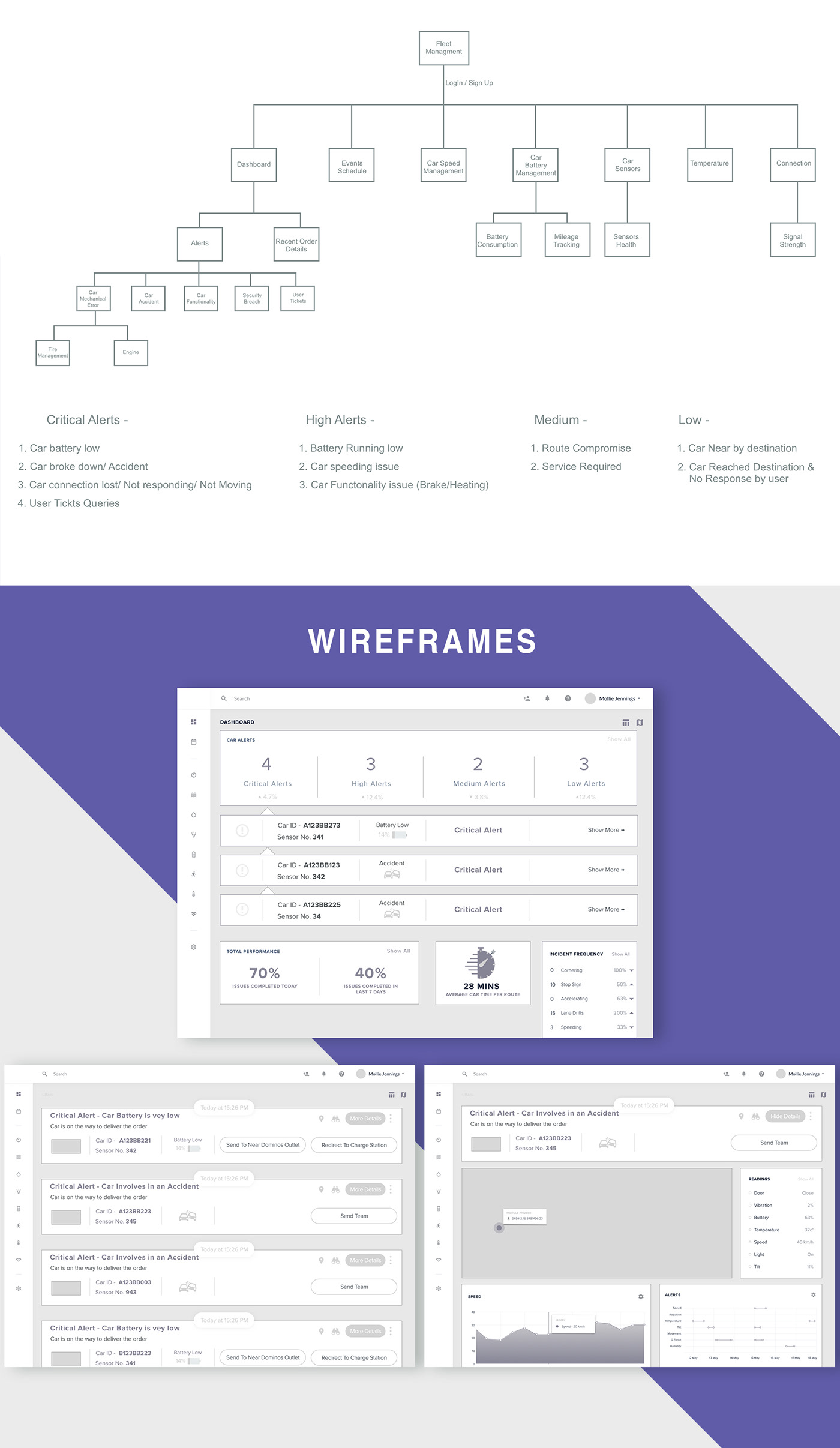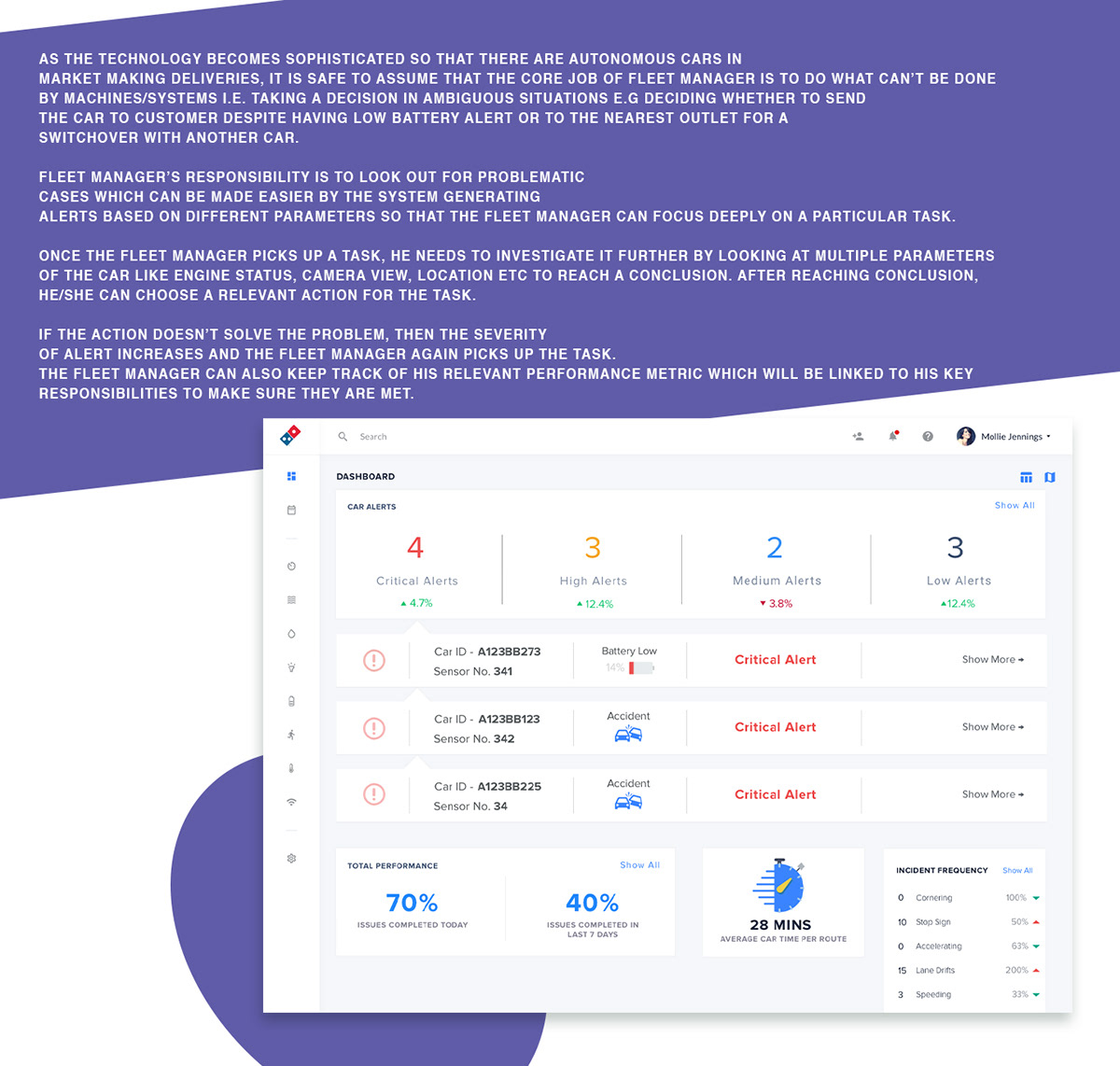
Problem Statement -
Design a dashboard for the One Fleet manager which will enable him to oversee and manage the entire fleet (more than 2000 autonomous driving vehicles in the city of San Francisco) of vehicles

Components -
The fleet manager immediately needs to know when any of the self-driving cars have broken down or facing some issues/errors.
Alerts -> Investigate -> Actions
Alerts -
1. Organizing Alerts by Severity: I have implemented a categorization system for alerts, dividing them into four distinct categories based on their severity levels. This classification ensures that fleet managers can prioritize their responses according to the urgency and criticality of each alert.
- Critical Alerts: These alerts represent the most severe issues that require immediate attention and intervention to prevent potential accidents or significant disruptions to operations.
- High Alerts: This category encompasses alerts that signify important issues requiring prompt action to mitigate potential risks or operational disruptions.
- Medium Alerts: Alerts categorized as medium severity indicate issues that need attention but may not be as urgent or critical as high or critical alerts. Nonetheless, they still require timely resolution to prevent escalation.
- Low Alerts: Alerts in this category represent minor issues or informational notifications that do not pose immediate risks or require urgent action but should still be monitored and addressed as part of routine maintenance and management practices.
- Critical Alerts: These alerts represent the most severe issues that require immediate attention and intervention to prevent potential accidents or significant disruptions to operations.
- High Alerts: This category encompasses alerts that signify important issues requiring prompt action to mitigate potential risks or operational disruptions.
- Medium Alerts: Alerts categorized as medium severity indicate issues that need attention but may not be as urgent or critical as high or critical alerts. Nonetheless, they still require timely resolution to prevent escalation.
- Low Alerts: Alerts in this category represent minor issues or informational notifications that do not pose immediate risks or require urgent action but should still be monitored and addressed as part of routine maintenance and management practices.
2. Prominent Display on Dashboard: On the Dashboard homepage, I have ensured that all alert categories are prominently showcased at the top of the interface. This layout allows fleet managers to easily locate and access the alerts, providing them with immediate visibility into any potential issues or concerns within the fleet. By placing the alert categories in a prominent position, fleet managers can quickly assess the overall status of the fleet and prioritize their actions accordingly.
3. "Show More" Call-to-Action: To facilitate further investigation and resolution of specific alerts, I have implemented a "Show More" call-to-action (CTA) feature. This functionality enables fleet managers to delve deeper into individual alerts by accessing additional details and suggested actions for resolution. By clicking on the "Show More" CTA, fleet managers can gain a comprehensive understanding of the alert and take appropriate measures to address the issue promptly.
This proactive approach helps ensure that potential issues are promptly identified, investigated, and resolved, minimizing any potential impact on fleet operations and safety.
Investigation -
The fleet manager has the ability to thoroughly investigate the alert case to gain a deeper understanding and identify the underlying issue causing the alert.
Actions -
Following a thorough investigation of the alert case, the fleet manager will compile a list of actions necessary to resolve the alert issue.


Additionally, there are other areas where Fleet managers can focus to enhance the professionalism of deliveries and optimize the Fleet system to align with business needs more effectively, like -
ENHANCE REAL-TIME DISPATCHING TO ELIMINATE OVERLAPS -
Dispatching is a critical operation for any transportation company, involving the coordination and management of various tasks such as scheduling, route planning, vehicle availability, and tracking order deliveries. However, one of the primary challenges faced in dispatching is dealing with information overload.
This entails the need to continuously update and monitor schedules, routes, vehicle statuses, order delivery statuses, and other relevant information in real-time. Maintaining accurate and up-to-date data is essential for efficient dispatching operations and ensuring timely and reliable deliveries. Therefore, streamlining and automating these processes can significantly enhance the effectiveness and efficiency of dispatching operations, ultimately leading to improved customer satisfaction and operational performance.
BE REMINDED OF TIMELY MAINTENANCE TO REDUCE PROBLEMS ON ROAD -
To prevent inconvenient situations arising from vehicle downtime due to accidents, connection loss, or low battery levels, it's essential for managers to continually monitor their vehicles' statuses and conditions. The Fleet Management System provides a comprehensive solution for this, allowing managers to efficiently track the maintenance needs of their vehicles.
With this system in place, alerts and reminders ensure that scheduled inspections and repairs are never overlooked. Additionally, real-time updates on the fleet's status enable managers to stay informed and proactive in addressing any issues as they arise. By leveraging the Fleet Management System, managers can effectively mitigate downtime, enhance vehicle maintenance practices, and optimize fleet operations for greater efficiency and reliability.


